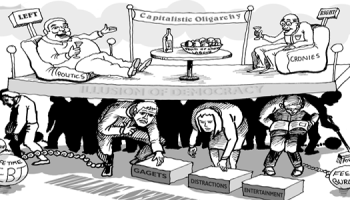A Weighty Problem

Fat. I watched the university students ascending the stairs to enter the Liberal Arts building and realized that most of the people I observed were overweight and some even struggled to make it up the flight of 13 stairs.
I wondered as I thought of these changes, how the problems of urbanization, changes in family eating patterns and capitalization of food commodities had changed in Peru and if they too were affected by this global epidemic of weight gain.
I was transported to my own youth, where the occasional person was considered overweight, and advertisements were common in magazines for weight gain elixirs. Women worried about not having curves, having skinny thighs or calves, or being seen as poor because of their thin bodies.
Contrast the advertisements between this 1960’s ad and this one from 2004.


The attitude toward fat has changed, and it is no longer seen as ‘popular’. I wondered if a similar change had taken place in Peru.

The fetishization of thinness has had effects on the view of beauty in Peru as well. It was once considered a sign of status and beauty to have a few extra pounds. Hacienda owners were corpulent, while the workers were excruciatingly thin.

In Peru, there are also stories of carisiri who steal fat, because it is a valuable substance and necessary for life. The image of the Ekko is also one of a corpulent man who is wealthy and happy.
The ideal of well-padded fell from grace, but despite its decline in popularity the United States is now ranked as the ‘fattest nation in the world’ with almost 72% of people weighing in as overweight or obese. According to El Comercio, in 2013, “more than 40 percent of the adult population in Peru is overweight or obese” Further, according to Jaime Villena, the president of the Peruvian Society of Endocrinology.
“The sedentary lifestyle, consumption of foods rich in fat, salt and sugars, but poor in vitamins, minerals and other micro nutrients are the primary cause of obesity in children and adults,”
One of the greatest risks of being overweight are the problems associated with excessive fat, on of which is metabolic syndrome. To define metabolic syndrome, I consulted the US National Institute of Health guidelines for symptoms which read:
- A large waistline.
- A high triglyceride level (or you’re on medicine to treat high triglycerides).
- A low HDL cholesterol level
- High blood pressure .
- High fasting blood sugar
Additionally, many to most people in the United States and many people in Peru are at risk of developing diabetes According to the 2014 International Diabetes Federation (IDF) report, the estimated “Peruvian diabetes prevalence in adults (20-79 years old) was 6.1%. This corresponds to 1,143,600 million people with diabetes in Peru, with 317,700 of them undiagnosed.”
There are differences between the high Andes and the lowlands however, with a much lower prevalence observed in the areas of higher elevation. Weight gain, is however, still a problem.
Because of the complexity of the issue, I will continue to write next week on the factors that have impacted weight gain in Peru and the US, and ongoing concerns for health.




